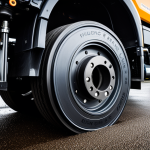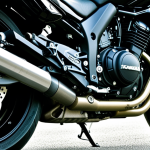Understanding the Importance of the Steering Damper on the Honda VTR1000F
The steering damper function plays a crucial role in maintaining motorcycle stability, especially on the Honda VTR1000F. This component reduces sudden handlebar oscillations, commonly known as “tank slappers,” which can compromise control during high-speed riding or uneven terrain. By absorbing and smoothing out abrupt steering movements, the steering damper greatly enhances rider confidence and safety.
Common symptoms of a worn or faulty steering damper include excessive handlebar vibration, difficulty maintaining a straight line, and increased susceptibility to front-end wobbling. When these signs appear, the bike’s stability is compromised, increasing the risk of accidents.
Have you seen this : Mastering Valve Timing: The Definitive Guide to Optimizing Your Yamaha YZF-R1 for Peak Performance
Timely replacement of the steering damper is critical. Delaying service can result in worsening control issues and additional stress on the motorcycle’s suspension and frame. Ensuring your Honda VTR1000F’s steering damper is in optimal condition protects both the rider and the bike’s performance, making it an essential maintenance item that should not be overlooked.
Understanding the Importance of the Steering Damper on the Honda VTR1000F
The steering damper plays a crucial role in the Honda VTR1000F steering system, enhancing motorcycle stability by reducing unwanted handlebar oscillations, commonly known as “headshake.” Its primary function is to absorb and dampen sudden steering movements caused by uneven road surfaces or high speeds, providing a smoother and safer ride.
Also to read : Revamp Your Kawasaki ZZR1400: The Ultimate Guide to Upgrading Foot Pegs for an Enhanced Ride Experience
When the steering damper wears out or becomes faulty, common symptoms include excessive handlebar vibrations, shaky front-end feedback, and an unstable riding feel. Such issues directly affect motorcycle stability, making the bike more difficult to control, especially during fast cornering or rough terrain riding.
Timely replacement of the steering damper is critical not only to restore precise handling but also to ensure rider safety. An inefficient steering damper compromises control and can lead to dangerous situations, increasing the risk of accidents. For the Honda VTR1000F, maintaining a fully functional steering damper guarantees consistent steering response and contributes to the overall longevity of the motorcycle’s handling components.
Selecting the Right Replacement Steering Damper
Choosing the correct steering damper for your Honda VTR1000F is vital for restoring optimal motorcycle stability. When selecting a replacement, consider the steering damper function—look for models specifically designed to control handlebar oscillations and improve ride smoothness. Quality dampers offer adjustable resistance settings to tailor performance according to riding conditions.
A major question riders face is: should they opt for OEM parts or aftermarket alternatives? OEM Honda VTR1000F replacement parts guarantee compatibility and reliability, maintaining manufacturer standards. However, reputable aftermarket brands often provide enhanced features such as improved damping technology or lighter weight materials. It’s crucial to evaluate product reviews and test results to identify the best steering dampers for your bike.
Notable brands for the VTR1000F include Öhlins and K-TECH, known for their precision engineering and durability. These steering dampers significantly enhance motorcycle stability by reducing front-end wobble. Prioritize units designed for the VTR1000F model to ensure proper fitment and function. Ultimately, selecting the right steering damper balances performance preferences with budget and maintenance goals.
Selecting the Right Replacement Steering Damper
Choosing the best steering damper for your Honda VTR1000F involves considering several key factors to ensure optimal motorcycle stability. The steering damper function must effectively reduce unwanted handlebar oscillations without compromising steering feel. Look for dampers with adjustable settings that allow riders to customize resistance based on riding conditions, enhancing safety and comfort.
One common question is whether to opt for OEM or aftermarket parts. OEM steering dampers guarantee compatibility and original design standards, but aftermarket options often provide enhanced features, improved durability, or reduced weight at competitive prices. However, quality varies widely among aftermarket brands, so selecting reputable manufacturers known for precision engineering is critical.
Notable brands produce steering dampers specifically tailored for the Honda VTR1000F, balancing performance and reliability. These units frequently include corrosion-resistant materials and smooth damping mechanisms that maintain consistent Honda VTR1000F steering feel, even under aggressive use.
Prioritizing a steering damper designed for your bike model ensures seamless integration with the existing frame and fork geometry. This precise fit contributes significantly to motorcycle stability and rider confidence, reinforcing why selecting the right replacement steering damper is not just an upgrade—it is essential for maintaining safe handling performance.
Essential Tools and Preparation for Replacement
Before starting your steering damper installation on the Honda VTR1000F, gathering the right motorcycle maintenance tools is crucial. You will need the following items: a torque wrench for accurate tightening, Allen keys or hex wrenches matching the damper bolts, a socket set, and screwdrivers. Having penetrating oil is helpful if fasteners are corroded or stuck.
Ensuring workshop safety is equally important. Use gloves and eye protection to prevent injuries. Secure the bike on a stable stand or lift to avoid unexpected movement during damper removal or installation. Check for proper lighting and clear your workspace for easy access to tools and parts.
Preparing the Honda VTR1000F steering system involves cleaning the area around the damper to prevent dirt from entering mounting points. Inspect bolts and brackets for wear or damage before replacement. These steps help ensure the steering damper function is restored correctly and safely.
Following these preparation steps minimizes errors and protects both rider and motorcycle. Careful readiness simplifies the installation process, guaranteeing improved motorcycle stability once the new damper is fitted.
Essential Tools and Preparation for Replacement
Before beginning the steering damper installation on your Honda VTR1000F, gathering the right motorcycle maintenance tools is essential for a smooth process. Key tools include a torque wrench to secure bolts to manufacturer specifications, a set of Allen and socket wrenches for damper mounting hardware, and thread locker to prevent loosening under vibration. Also prepare clean rags and a container for any small parts.
Safety is paramount: always wear gloves and eye protection when working around the steering assembly. Ensure your workspace is well-lit, clean, and free from distractions. Position the motorcycle securely on a stand or lift to maintain stability during removal and installation, essential for safe handling.
Additionally, before starting the replacement, inspect the bike for rust or corrosion around the current damper’s mounts. This helps anticipate areas needing extra care, reducing risks of component damage or injury. Proper steering damper installation prep minimizes frustration and prevents delays caused by missing tools or unsafe conditions, streamlining the entire replacement process for better results.
Step-by-Step Process for Removing the Old Steering Damper
Removing the old steering damper on your Honda VTR1000F begins with securing the motorcycle safely. Use a stable stand or lift to keep the bike upright and prevent movement during the removal. This step is essential to avoid accidents and ensure precise handling while working.
Locate the damper mounting hardware, typically bolts attaching the damper to the frame and fork. Using the correct size Allen keys or socket wrenches, carefully loosen these fasteners. If bolts are corroded or stuck, apply penetrating oil and allow it to settle before attempting removal again to avoid stripping threads or damaging components.
During the Honda VTR1000F damper removal, support the damper to prevent it from dropping as you remove the bolts. Handle the unit gently—damper components can be delicate, and rough handling risks damage to adjacent parts of the Honda VTR1000F steering system.
Following these motorcycle repair steps diligently minimizes complications. Inspect old mounting points and hardware after removal for wear or deformation. Understanding these steps supports effective DIY motorcycle maintenance and prepares you for installing the new steering damper.
Selecting the Right Replacement Steering Damper
Choosing the ideal steering damper for your Honda VTR1000F requires understanding key features that directly impact motorcycle stability. A quality damper must deliver consistent resistance to control rapid handlebar oscillations while preserving smooth Honda VTR1000F steering feel. Adjustable damping levels are highly recommended, allowing riders to fine-tune performance based on road conditions or personal preference.
When debating steering damper selection, the choice between OEM and aftermarket parts arises. OEM Honda VTR1000F replacement parts guarantee perfect fitment and adherence to original specifications. Conversely, aftermarket options often offer technological enhancements such as lighter construction or superior fluid damping, albeit with varying compatibility. Selecting brands renowned for reliability and precise engineering reduces risks of improper function.
Recommended best steering dampers for the VTR1000F come from manufacturers like Öhlins and K-TECH, famed for durability and smooth operation. These brands focus on maintaining optimal motorcycle stability while resisting corrosion and wear, essential for long-term use. Prioritizing products designed specifically for the VTR1000F ensures seamless integration with the bike’s geometry and sustained steering precision.
Installing the New Steering Damper: Detailed Instructions
Begin steering damper installation by carefully aligning the new damper with the Honda VTR1000F mounting points. Proper alignment ensures that the damper functions smoothly, maintaining motorcycle stability without binding or excess stress on components. Misalignment can cause premature wear or compromised control.
Once aligned, loosely install the damper bolts by hand to confirm all holes line up correctly. Use a torque wrench to tighten bolts to the manufacturer’s specified torque settings, crucial for safe and reliable Honda VTR1000F steering. Over-tightening risks damaging threads, while under-tightening may allow the damper to shift during riding.
After securing the damper, verify clearance between the damper body, frame, and fork to avoid contact during full steering range. This check is essential for preserving the steering damper function and preventing damage.
Finally, cycle the handlebars through their full range of motion, feeling for smoothness and consistent resistance from the damper. Any unusual stiffness or rattling signals the need to recheck installation. Following these motorcycle assembly steps precisely guarantees restored handling and safety consistent with your Honda VTR1000F’s design.
Understanding the Importance of the Steering Damper on the Honda VTR1000F
The steering damper function is essential for maintaining motorcycle stability on the Honda VTR1000F. It minimizes sudden handlebar movements that can cause loss of control, especially at high speeds or on rough surfaces. By moderating oscillations, it protects the rider from dangerous “tank slappers” and contributes to safer, more precise Honda VTR1000F steering.
Common symptoms of a faulty steering damper include increased steering wobble, excessive vibration through the handlebars, and difficulty holding a straight line. These issues often indicate worn internal damping mechanisms or fluid leaks, which severely degrade the damper’s effectiveness. Ignoring these signs risks compromised handling and reduced safety.
Timely replacement of the steering damper is vital. A failing unit not only reduces motorcycle stability but also places extra stress on the front suspension and frame, potentially causing further damage. Ensuring your steering damper functions properly maintains the signature responsive control of the Honda VTR1000F, reinforcing confidence and rider safety on every ride.




